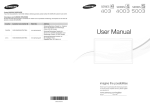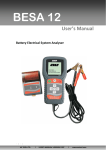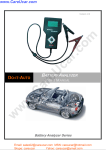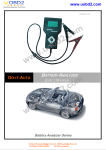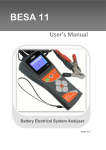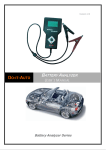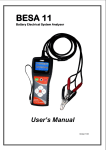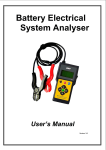Download BSA-12G User Manual A1410
Transcript
BSA-12G User Manual Version A1410 Introduction BSA-12G [Battery Starter Analyser] had revolutionized its display format and is the first in the world with full graphics display on its operation. With its simplicity of the graphics display, step by step instructions were clearly understood universally without any language barrier. It is able to test all 12V Automotive and Motorcycle Batteries. With its microprocessor controlled testing, the results were accurate and repeatable. The operation is quick (less than 7 sec) and does not create sparks when clipped on or drain the battery during the test. It does not carry any internal batteries. Itis powered up from the testing battery or from an external DC source ranging from 9V to 15V DC which is meant for operating on 12V flooded lead acid, sealed lead acid, and VRLA, Gel or AGM batteries. No maintenance is required during its lifetime service. Specifications: Operating Voltage: 9V ~ 15V DC (max) Analysing Capacity (Amps): Automotive: CCA: IEC: JIS#: CA: 100A ~ 2000A 100A ~ 2000A 100A ~ 2000A 100A ~ 2000A Motorcycle: CCA: IEC: JIS#: CA: 40A ~ 600A 40A ~ 600A 40A ~ 600A 40A ~ 600A DC Volts Accuracy: ± 2% Reading Battery analysing time: EN: 100A ~ 2000A DIN: 100A ~ 2000A SAE: 100A ~ 2000A EN: 40A ~ 600A DIN: 40A ~ 600A SAE: 40A ~ 600A Less than 7 seconds. Working Temperature: 0ºC (32°F) ~ 50ºC (122ºF). Working Humidity: 10 ~ 80 % 1 USER MANUAL Version A1410 Safety precautions: • When the engine is running, it produces carbon monoxide, a toxic and poisonous gas. Always operate the vehicle in a well-ventilated area. Do not breathe exhaust gases – they are hazardous that can lead to death. • To protect your eyes from propellant object such as caustic liquids, always wear safety eye protection. • Fuel and battery vapors are highly flammable. DO NOT SMOKE NEAR THE VEHICLE DURING TESTING. • When engine is running, many parts (such as pulleys, coolant fan, belts, etc.) turn at high speed. To avoid serious injury, always be alert and keep a safe distance from these parts. • Before starting the engine for testing or trouble shooting, always make sure the parking brakes is firmly engaged. Put the transmission in Park (automatic transmission) and Neutral (manual transmission). • Always block the drive wheels. Never leave vehicle unattended while testing. • Never lay tools on vehicle battery. You may short the terminals together causing harm to yourself, the tools or the battery. • Do not wear loose clothing or jewelry while working on engine. Loose clothing can get caught in fan, pulleys, belts, etc. Jewelry can conduct current and can cause severe burns if comes in contact between power source and ground. • Always keep a fire extinguisher readily available and easily accessible in the workshop. Working with Batteries: Lead-acid batteries contain a sulfuric acid electrolyte, which is a highly corrosive poison and will produce gasses when recharged and explode if ignited. It can hurt you badly. When working with batteries, make sure you have plenty of ventilation, remove your hand jewelry, watch and wear protective eyewear (safety glasses), clothing, and exercise caution. Do not allow battery electrolyte to mix with salt water. Even small quantities of this combination will produce chlorine gas that can KILL you! Whenever possible, please follow the manufacturer's instructions for testing, jumping, installing, charging and equalizing batteries. 2 USER MANUAL Version A1410 • Never disconnect a battery cable from a vehicle with the engine running because the battery acts like a filter for the electrical system. Unfiltered [pulsating DC] electricity can damage expensive electronic components, e.g., emissions computer, radio, charging system, etc. Turn off all electrical switches and components; turn off the ignition before disconnecting the battery. • For non-sealed batteries, check the electrolyte level. Make sure it is covering the plates and it is not frozen before starting to recharge (especially during winters). • Do not add distilled water if the electrolyte is covering the top of the plates because during the recharging process, it will get warm and expand. After recharging has been completed, recheck the level. • Do NOT smoke or cause sparks or flames while the battery is being recharged because batteries give off explosive gasses. Preparing for Test: 1. The Tester operates from 9V ~ 15V DC and should not be tested on 24V directly. It will cause damage the unit. For 12V x 2 batteries (in series or parallel), disconnect the connections and test them individually. 2. Battery that has just been charged by the charger contains surface charge and it should be discharged by turning ON the Head lights for 3~5 minutes before testing. 3. Always attached the tester clips on the lead side of the battery terminal posts during testing so that it has a good contact. This will provide better and accurate results. 4. Do not attach the tester clips directly onto the steel bolt that tightened to the battery terminal posts; this may give inaccurate readings or inconsistent results. (Note: This also applies to all other battery testing methods.) 5. During testing on the battery whist it is still in the car, make sure the engine, all accessories and load are OFF. Close the trunk lid and all doors. 6. Inspect the battery for cracks or broken casing. Do not use the Tester if the battery is damaged. 7. If the battery is a WET type: non sealed maintenance free, top up the level as specified by the markings on the battery with distilled water. This will help to purge the gas from the cells. DO NOT OVERFILL. 8. If necessary to remove the battery from the vehicle to test, ALWAYS remove the negative terminal from the battery first. Make sure all accessories are OFF so that you do not cause any arcing. 3 USER MANUAL Version A1410 Automotive Battery Test: Performing Battery Test whilst it is still in the car: Vehicle that was running has to have its engine OFF first and then switch ON the headlights for 30 seconds to remove the surface charge. After the headlights had switched OFF, let the battery rest for at least 1 minute to recover before testing commences. The car engine and all other accessory accesso loads must be OFF during test in order to have accurate results. When attaching the analyser clips, make sure that the battery posts were not oxidized or badly corroded. Clean them first before clamping to it. Do not clamp onto the steel bolts directly which may give inaccurate urate and inconsistent results. Testing on stand-alone Automotive Batteries: B Clean the battery posts with a wire brush prior testing. For side post batteries, install stud adaptors. Do not use steel bolts for better results. 1. Clamp the Tester black clip to the battery negative terminal (-) and red clip to the battery positive terminal (+). The Tester LCD will light up (Fig1). Fig.1 2. When one of the Tester clamps to the battery contact is not good, it will prompt you as shown below (Fig 2 and 3 flashing alternately).. In this case, unclamp and clamp the Tester clips again on the battery posts. Here the Tester will ensure that its contacts are good before conducting a test. Fig.3 Fig.2 3. If the contacts between the battery and the Tester have no problem then it will proceed for the test. First select the test from the menu ( Fig. 4): 4 View Last Test Results. New Test; Erase last test results Fig.4 Continue or Repeat Test 4 USER MANUAL Version A1410 4. Here, it will let you select your choice from the Menu: New Test; Erase last test results: Select this item to begin new test and clear the stored test results of last test in the memory. 5. Continue or Repeat Test: Selecting this item will continue or repeat the last test on the same battery or test from where you had stopped and update the results in its memory. For example: If you have done Battery Test and later wish to do Starter Test on the same car, just select this option and it will update the results in its memory every after test which you can retrieve or review later for print out. 6. View Last Test Results: This option lets you view all the stored test results in the memory. When selected, the display will show (Fig.5) as shown: Fig.5 Continuation from 3 above: 7. After you have made your choice, you can begin test by selecting proceed to the display below: (Fig.6) or will Fig.6 8. Selecting [Automotive] will allow you to test Batteries (up to 2000A) and Starters whereas [Motorcycle] will only test Batteries (up to 600A) only. Here if you have selected [Automotive] test, then there is an option to select Battery or Starter (Fig. 7 and 8). Fig.7 Fig.8 OR Select for Battery test and then press 5 USER MANUAL Version A1410 9. If the tester detected that the battery has surface charge, it will prompt you to turn the ignition key to ON and switch on the headlights (Fig.9) to discharge the battery until it has reached the next display that shows turn ignition OFF and headlights OFF (Fig.10) as display shown then press to continue. Fig.9 Fig.10 10. Next it will prompt you to select the types of batteries (Fig.11) : Fig.11 SLI battery is intended for normal flooded types like Wet Low Maintenance (Lead [Pb] / Calcium [Ca]) or Wet Standard (Lead [Pb] / Lead [Pb] ) batteries. AGM (Flat/Spiral) will test Wet (MF) Maintenance Free (Calcium [Ca] / Calcium [Ca] ), AGM/Gel Cell VRLA (Calcium [Ca] / Calcium [Ca]) batteries. 11. Before selecting the rating standard ‘CCA, SAE, EN, IEC, DIN, CA and JIS #’ from the menu, check the battery specification for corresponding Ampere value. This value can be checked on the battery labels as some of the examples shown below: 12. Once desired rating standard selected, it will proceed to the display as shown below (Fig.12): Fig.12 13. If the rating selected is JIS # (Japanese Industrial Standard), you need to convert to CCA rating by referring to the conversion chart provided separately with the Tester. Refer to the battery model (example: 80D26L or NX110-5L) on the Cold Cranking Amps (CCA) , WET is 580 CCA and AGM is 630 CCA. 6 USER MANUAL Version A1410 14. You can also refer through CCA guide below, basing on the engine capacity of the vehicle. However, the percentage (%) Life is not that precise as compare to the actual battery rating as this is only a rough estimate. 1000 – 1299 cc 1300 – 1599 cc 1600 – 1999 cc 2000 – 2999 cc 3000 – 3500 cc 300 CCA 400 CCA 500 CCA 700 CCA 800 CCA 15. To enter the value, press ⊳ keys to increase or decrease the original value by 100 shown on the display. Likewise use keys to increase or decrease the last two digits by 5. Fig.13 16. Once the Amps rating of the battery is confirmed, press the display below (Fig.14): key and the test starts. Refer to Fig.14 17. In less than 7 seconds, the results of the test will be displayed on the LCD screen. State of Charge (SOC) Power available Internal Resistance Life [Health] Battery Result Fig.15 18. This Analyser will also takes into consideration the temperature of the battery when it detects that the battery condition is marginal (SOC below 75%) and it will prompt you with the display as shown ( Fig. 16) below: 7 USER MANUAL Version A1410 (+) 0°C and above (-) 0°C and below Fig.16 Here it lets you to select the surrounding temperature that you are working with the battery. If the surrounding temperature is for example 15°C, then select and press . Then the results will show on the LCD display. Motorcycle Battery Test To test motorcycle batteries, it is better to test with the battery taken out from the motorcycle for better results. This is mainly due to the obstruction of the wires that are attached to the battery terminals and the tester clamps may not clip properly due to lack of space at its terminals thereby may cause false test results. 19. While on the main menu as shown Fig.17 below, select (Fig.18). Fig.17 for Motorcycle Battery test Fig.18 20. Press and the screen will show as Fig.19 below: Fig.19 21. Before selecting whether [SLI] or [AGM] and the ratings ‘CCA, SAE, EN, IEC, DIN, CA and JIS #’ from the menu, check the battery model. This can be checked on the battery labels as some of the examples shown below: With the battery model in hand, refer to the Battery rating chart ( as seen in this example Fig.17 below) provided in separate copies with the Tester during purchased to get values to be keyed in. 8 USER MANUAL Version A1410 Fig.20 22. Once the battery type [SLI] or [AGM] is selected, it will proceed to the display as shown below (Fig.21): Fig.21 23. Press and the display will show as in Fig.22. To enter the value, press key ⊳ to key to increase or increase or decrease the original value by 100. Likewise use decrease the last two digits by 5. Fig.22 24. Once the Amps rating of the battery is confirmed, press the display below (Fig.23): key and the test starts. Refer to Fig.23 25. For less than 7 seconds, the results will be displayed on the LCD screen (Fig. 24) State of Charge (SOC) Power available Internal Resistance Life (Health) Battery result Fig.24 9 USER MANUAL Version A1410 Interpretation of Results: 1. The battery is in good condition. The battery is no good, need to be replaced with a good one. This shows that the battery need to recharge first and then test again to confirm the final results. 2. Volts : 12.68V (State of Charge [SOC]) The volts here indicate the State of Charge (SOC) of the battery on test which is 12.68V during open circuit condition. [Above 80% SOC for AGM batteries by referring to the table below.] State Of Charge(SOC) 100 % 90 % 80 % 75 % 50 % 25% 0% 3. WET AGM GEL 12.60V 12.58 V 12.44 V 12.40 V 12.20 V 12.00 V 11.80 V 12.80V 12.72 V 12.64 V 12.60 V 12.30 V 12.00 V 11.80 V 12.85V 12.77 V 12.69 V 12.65 V 12.35 V 12.00 V 11.80 V Power available: 190 CCA It means that the battery on test has a capacity of 190 CCA power available. CCA rating is used, therefore the tested result is in CCA and if other rating (DIN, SAE, JIS, IEC, CA, or EN) are selected, it will base on the respective rating to calculate and show the results. Please take Note: This output value (190 CCA) is related to the actual power available in the battery in relation to that battery's rating (210 CCA). On average, a new battery's CCA as measured by this tester will read 10-15 % higher than its stated rating. As the battery ages, the CCA number measured by this tester will decrease so it reads near its rating. 10 USER MANUAL Version A1410 While this value is not the same as a CCA test, it is the best available measurement for showing a battery's current condition in relation to its rating. From the above example, a 210 CCA rated battery measuring 190 CCA available power does not mean that the battery would pass a CCA test at 190 CCA. The available power reading shows that the battery is not able to perform up to its rated ability (210 CCA). In comparison to another battery when fully charged, the 210 CCA battery measuring 190 CCA is no stronger than a 100 CCA battery showing 100 CCA available power when fully charged. The available power number is meant for comparison to its own rating. In fact, in this example the 210 CCA battery is failing to perform to its rating, while the 100 CCA battery is still working. Basing on SAE, CCA test is a manufacturing process control test applicable only on new, fully charged batteries. It does not produce an actual value, but is a PASS / FAIL test. It measures the discharge load, in amps, that a battery can supply for 30 seconds at 0°F/-18°C while maintaining a voltage of 1.2 volts per cell (7.2 volts per battery) or higher. Thus, the CCA test shows the minimum power requirement for the battery as rated, which means a battery rated at 400 CCA must measure 7.2 volts or above for 30 seconds when a load of 400 amps is applied at 0°F/ -18°C. The above methods also hold for DIN, IEC, JIS, EN basing on its individual ratings. 4. Internal Resistance: 14.65mΩ In normal condition, the internal resistance of the automotive battery should fall between the range of 2.0 mΩ ~ 15.0 mΩ. is considered good. Anything above 15.0 mΩ resistance shows that its internal plates has been aged or sulfated. For motorcycle batteries, its internal resistance of 5.0 mΩ ~ 45.0 mΩ is considered good due to low CCA value it has. As a matter of fact, the higher the battery CCA readings obtained the lower the internal resistance should be. 5. LIFE: 80 %(Health) This is an indication of the battery life expectancy [Health] in percentage. If the life falls below 45 %, the RESULT will display “Replace” and it is time to change to a new battery. 11 USER MANUAL Version A1410 Explanation of the following terms used as shown on the LCD display: • CCA (Cold Cranking Amps) – most commonly used Standard. CCA is a rating used in the battery industry to rate a battery’s ability to start an engine in cold temperatures. This rating is the number of amperes that a new fully charged battery can delivery at 0°F (-18°C) for 30 seconds, while maintaining a voltage of at least 7.2 Volts for a 12V battery during cranking. • SAE (The Society of Automotive Engineers) Standard. SAE has established Cold Cranking Amperes (CCA) rating for batteries as their standard. Therefore this rating is the same as CCA rating as mentioned above. • IEC (International Electrotechnical Commission) Standard. IEC amperes rating require that at 0°F (-18°C), the number of amperes that the 12V battery can deliver while maintaining a voltage of at least of 8.4 Volts for 60 seconds during cranking. • EN (European Norms) Standard. EN amperes rating require that at 0°F (-18°C), the number of ampere that the 12V battery can deliver while maintaining a voltage of at least 6.0 Volts for 180 seconds during cranking. • JIS# (Japanese Industrial Standard) JIS # amperes’ rating is based on Ampere Hours and is calculated using 20 hours rating. In this manual, it is using CCA ratings reference table list provided basing on the JIS model number. • DIN (Deutsches Industrie Normen)Standard. Basing on DIN , the rating requires that at 0°F (-18°C), the 12V battery is able to deliver the number of amperes while maintaining a voltage of at least of 9.0 Volts for 30 seconds and 8.0 Volts for 150 seconds during cranking. • CA (Cranking Amperes) Rating. This rating is the number of amperes that a new fully charged battery can delivery at 32°F (0°C) for 30 seconds, while maintaining a voltage of at least 7.2 Volts for a 12V battery during cranking. • ?? (Unknown) If you are not sure which ratings (CCA, EN, IEC, JIS or DIN) that the battery is based on, then choose this setting. It will show the battery’s Voltage (State of Charge), CCA and the Internal Resistance (m Ohm) only. This selection can also be used to test 12V - Deep Cycle Batteries. An example of the results display is shown below: (Fig.25) Fig.25 12 USER MANUAL Version A1410 To determine the condition of Deep Cycle Batteries on test, the Volts reading – State of Charge (should not fall below 12.60V when fully charged for Lead Acid Batteries, 12.85V for Gel Batteries and 12.80V for AGM Batteries) and the Internal Resistance [Int. R] of the tested battery should not be more than 15mΩ considered to be a good battery. 26. Batteries that had been left idle for long periods can still be tested with this analyser. To perform the test, just clamp the analyser clips onto the battery terminals and the results will display onscreen (Fig.26) as shown if its voltage falls below the normal 12.0 volts. State of Charge (SOC) Fig.26 Press key to continue and the display will show: (Fig.27) Fig.27 Check the battery ratings and enter it as described earlier and the results will show as an example below: (Fig. 28 and Fig.29) Fig.28 Fig.29 Fig.28- Results shown [Recharge and test again], it indicates that the battery has to be fully charged first before repeating the test. Reason: State of Charge: 11.09V is too low. For Fig.29 - Results shown [To replace], this meant that the battery need to be replaced as its internal plate resistance [Int. R] 20.56 mΩ is higher than 15 mΩ limit. 27. By pressing the (Fig.17). key at any moment will exit and return back to the main menu screen Starter Test: This test is only available in [Automotive] option and it actually checks the cranking effectiveness of the battery during starting and also the starter condition. 1. With engine OFF, place the vehicle transmission in NEUTRAL for Manual and PARK for Automatic then apply the parking brake. 2. Connect the tester to the battery terminals and the display will light up as shown. 13 USER MANUAL Version A1410 3. From the main MENU, select ‘Starter Test’ by scrolling left using show: 4. Press key. The screen will State of Charge before cranking key to continue and the display will show: show Note: In event that you did not crank the engine while on this screen, the starter test will terminate after 30 seconds and return to the main menu. 5. Now switch witch the ignition key to ON and start cranking the engine until it starts. 6. The results display will show as an example below: Normal Drop Voltage 7. Pressing the High voltage drop Less than 9.6V key will exit and return back to the main menu screen (Fig.17). (Fig. View Test Results from memory: To view all the test results, BSA--12G has to be connected to an external power source by either clamping its clips directly to a 12 volt car battery or connect to PC via the USB port using USB cable. 14 USB cable USER MANUAL Version A1410 1. Once power up, the wakeup screen will display as follows: (Fig.30&31) (Fig. Fig.30 Fig.31 2. Select View Last Test Results Re from memory by scrolling the (Fig.32): key. See display below Fig.32 3. Once key is pressed, the display will show as follows (Fig. 33): Fig.33 Personal Computer (PC) Link: BSA-12G 12G is also designed to link with PC for data storage and printout through normal printer. To do so, the PC has to install the driver first and the software provided in order to operate. Installing Driver Important to Note: Before you start to install the driver, please do not plug BSA-12G BSA 12G into the computer’s USB port or else the installation will fail and the computer cannot detect detect the proper driver for BSABSA 12G when connected. If you have made the above error and wish to install the driver the second time, you need to uninstall the previously installed driver first before starting starti to reinstall again. n. This time make sure that BSA-12G 12G is not plugged in. Step 1. You can install the driver as provided First click to open the folder: 15 USER MANUAL Version A1410 You will find the following files: Step 2. Double click on the icon . The installation will start automatically. Typical example below is for Windows 7 operating system. As instructed, click [Next>] tab the program will continue to install the driver on the computer. Once it had finished, it will prompt you as shown below. Click [Finish] tab to complete the installation. Step 3. Next open this folder again: Look for the program icon: Then double click to open the program. See examples below: 16 USER MANUAL Version A1410 Click “Install” tab to continue the installation and the software will start to install. A few seconds later, the display will show as below that the installation has been completed and click “Finish” tab to exit. Once the software has been installed, the icon will appear on the desktop. Step 4. Now plug the Analyzer into any one of the PC USB port and try to link up BSA-12G with the PC by the following procedures: 1. Go to the main Menu (Fig.34), select View Test Results (Fig.35) as shown below: Fig.34 Press Fig.35 key will get into the test result display as example shown (Fig.36). Fig.36 2. Press USB key on the keypad will display (Fig.37) as shown below: Fig.37 17 USER MANUAL Version A1410 It will remain in this display while logging into the PC. Do not press any other keys because the Analyser is already communicating with the PC. Step 5. On the PC, go to desktop display and look for icon. Left click on the icon to open the program and the display page will show as below: COM No. Auto fill in It will automatically detect COMPort. Customer License Plate Battery Model Capacity Header & Footer. Click here to put your Company name and address. Add the above particulars to test report. Get data from Analyser Print Save [Get Data from 1. To confirm whether there is communication; click on Analyser] tab and the Last Test Result will appear. See example below. You can type in the particulars here and then click [Add to Test Report] tab to be included in the test report which will be stored and printed out if you wish. 18 USER MANUAL Version A1410 2. If there is no communication, a message text box will appear (see below) Fig. 83 . Fig.83 83 In this case, unplug the Analyzer from the PC and repeat Step 4 and Step 5. If problem persist, then select an alternate COMPORT individually from the dropdown list and click [Get Data from Analyser] tab to see whether the Last Test Result will appear (as displayed in Step 5). If the above fails again, then try plugging the Analyzer to the PC’s another USB port and repeating Step 4 and 5 again. Printing Results from PC Printer: While on this page, if you wish to print out the results, make sure that your printer is connected to the computer. Click on tab and a text box will appear. Select the right printer and click [Print] tab to print. Select the printer which is connected to your computer here. Saving Results: Note: The results will be saved in MS Office Word Document format. You need to set the paper size to A4 beforehand if not the printout and the stored results page will not be in A4 size. Otherwise with other paper size settings, they may affect the layout of the results when printed out because of the graphics involved. To do so while in MS Office Word page, go to [Page Layout] tab and right click, display shows as in Fig. A. 19 USER MANUAL Version A1410 Right click here Fig. A Right click here On [Page Layout], right click on sign (see Fig. A) to show Page Setup dialogue box as shown (Fig. B) below. Then select [Paper] tab and browse [paper size] drop down menu for A4 click on it (Fig. C). Click [OK] to apply and confirm. Fig. C Fig. B To the save results, click on tab. A message box (see below) will appear. Create a file name and then click [Save] tab as shown below. The document will be saved in this folder BESA-12G in drive C: Create your file name and type in here. 20 USER MANUAL Version A1410 Disclaimer All information, illustrations, and specifications contained in this user manual are based on the latest information available at the time of printing. The right is reservedto make any changes at any time without obligation to notify any person or organization of such revisions or changes. Furthermore, the manufacturer or its sales agents are not liable for errors contained herein or for incidental or consequential damages (including lost profits) in connection with the furnishing, performance or use of this material. This user manual tells how to use and perform the required procedures on vehicles. Safe and effective use of this tester is very much dependent on the user following the normal practices and procedures outline in this manual. Warranty Information Limited Warranty This limited warranty cover defects in materials and workmanship for a period of twelve (12) months which begins from the date the product is purchased by the end user and is subjected to the following terms and conditions: 1. Within the warranty period, the manufacturer will repair or replace, at their options, any defective parts and return to the owner in good working condition. 2. Any repaired or replaced parts will be warranted for the balance of the original warranty or three months (3) months from the date of repair, whichever is longer. 3. This warranty only extends to the first owner and not assignable or transferable to any subsequent owner. 4. Cost of delivery charges incurred for the repair of the product to and from the manufacturer will be borne by the owner. 5. This limited warranty covers only those defects that arises as a result of normal use and does not cover those that arises as a result of: • Unauthorized modifications and repair. • Improper operation or misuse. • Accident or neglect such as dropping the unit onto hard surfaces. • Contact with water, rain or extreme humidity. • Contact with extreme heat. • Cables that have broken, bent contact pins or subject to extreme stress or wear. • Physical damage to the product surface including scratches, cracks or other damage to the display screen or other externally exposed parts. Limitations of Warranty Other than the foregoing limited warranty, the manufacturer does not make any other warranty or condition of any kind, whether express or implied. Any implied warranty of merchantability, or fitness for use shall be limited to the duration of the foregoing limited warranty. Otherwise, the foregoing limited warranty is the owner’s sole and exclusive remedy and is in lieu of all other warranties whether express or implied. 21 USER MANUAL Version A1410 The manufacturer or any of its exclusive sales agents shall not be liable for any consequential or incidental damages or losses arising of the loss of uses of this product. All warranty information, product features and specifications are subjected to change without prior notice. 22 USER MANUAL Version A1410






















